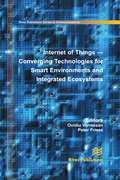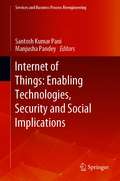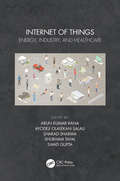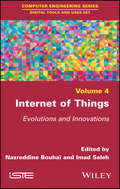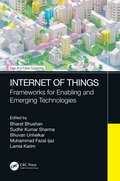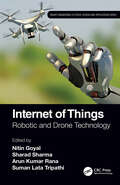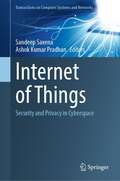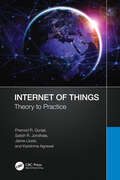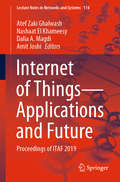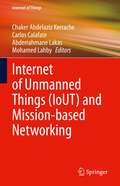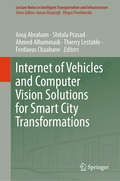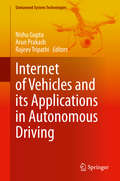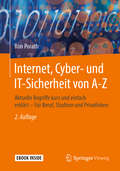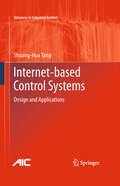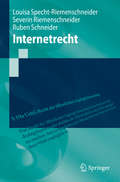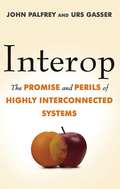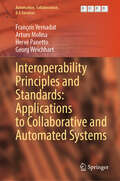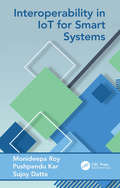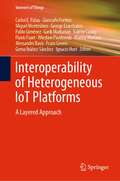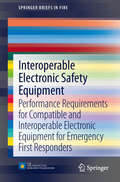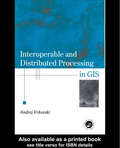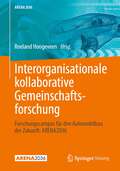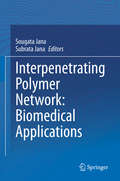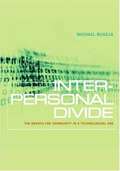- Table View
- List View
Internet of Things: Converging Technologies for Smart Environments and Integrated Ecosystems (River Publishers Series In Communications Ser.)
by Ovidiu Vermesan Peter FriessThe book aims to provide a broad overview of various topics of the Internet of Things (IoT) from the research and development priorities to enabling technologies, architecture, security, privacy, interoperability and industrial applications. It is intended to be a standalone book in a series that covers the Internet of Things activities of the IERC ? Internet of Things European Research Cluster from technology to international cooperation and the global state of play. The book builds on the ideas put forward by the European research Cluster on the Internet of Things Strategic Research Agenda and presents global views and state of the art results on the challenges facing the research, development and deployment of IoT at the global level.Today we see the integration of Industrial, Business and Consumer Internet which is bringing together the Internet of People, Internet of Things, Internet of Energy, Internet of Vehicles, Internet of Media, Services and Enterprises in forming the backbone of the digital economy, the digital society and the foundation for the future knowledge and innovation based economy in supporting solutions for the emerging challenges of public health, aging population, environmental protection and climate change, the conservation of energy and scarce materials, enhancements to safety and security and the continuation and growth of economic prosperity.Penetration of smartphones and advances in machine to machine and wireless communication technology will be the main drivers for IoT development. The IoT contribution is in the increased value of information created by the number of interconnections among things and the transformation of the processed information into knowledge shared into the Internet of Everything.
Internet of Things: Enabling Technologies, Security and Social Implications (Services and Business Process Reengineering)
by Santosh Kumar Pani Manjusha PandeyThis edited book presents point of view and the work being undertaken by active researchers in the domain of IOT and its applications with societal impact. The book is useful to other researchers for the understanding of the research domain and different points of views expressed by the experts in their contributed chapters. The contributions are from both industry and academia; hence, it provides a rich source of both theoretical and practical work going on in the research domain of IOT.
Internet of Things: Energy, Industry, and Healthcare
by Arun Kumar RanaInternet of things (IoT) is the connection and communication of physical objects (smart devices) over the internet. In this recent age, people’s daily lives are dependent on the internet through their smartphones, tablets, Smart TVs, micro-controllers, Smart Tags, computers, laptops, and cars to name a few. This book discusses different ways to create a better IoT network and/or IoT platforms to improve the efficiency and quality of these products and subsequently their users' lives. In addition, this book provides future research directions in energy, industry, and healthcare, and explores the different applications of IoT and its associated technologies. It provides an overview and explanation of the software architecture, middleware, data processing and data management as well as security, sensors, actuators and algorithms used to create a working IoT platform. The editors then go on to examine IoT networks and platforms as they relate to energy industry including, energy efficiency and management, intelligent energy management, smart energy through blockchain and energy-efficient/aware routing/scheduling challenges and issues. They then explore IoT as it applies to healthcare including biomedical image and signal analysis and disease prediction and diagnosis. Finally the editors examine the prospects and applications of IoT for industry through the concepts of smart industry, including architecture, blockchain, and Industry 4.0. This book is intended for senior undergraduate and graduate students, researchers and industry professionals working on IoT applications and infrastructure.
Internet of Things: Evolutions and Innovations
by Imad Saleh Nasreddine BouhaïThe development of connected, communicating objects is showing no signs of slowing down. With an increasing number of objects available on the market, the evolution of the Internet of Things is leading to more and more fields being explored via information and communication sciences. This book analyzes the ecosystem of the Internet of Things by retracing the historical and technological context of the Internet's evolution from traditional to dynamic, social and semantic, and then towards this ecosystem of connected objects. The evolution of concepts surrounding the Internet of Things is explored via real-life examples of connected objects; both those used for specific functions and for more general everyday objects. Numerous issues associated with these new technological and digital transformations in a "hyperconnected" world, as well as the impact of the massive influx of connected objects, are discussed. The crucial questions of potential intrusion into the private lives of users as well that of security are then studied.
Internet of Things: Frameworks for Enabling and Emerging Technologies (Edge AI in Future Computing)
by Bharat BhushanToday, Internet of Things (IoT) is ubiquitous as it is applied in practice in everything from Industrial Control Systems (ICS) to e-Health, e-commerce, Cyber Physical Systems (CPS), smart cities, smart parking, healthcare, supply chain management and many more. Numerous industries, academics, alliances and standardization organizations make an effort on IoT standardization, innovation and development. But there is still a need for a comprehensive framework with integrated standards under one IoT vision. Furthermore, the existing IoT systems are vulnerable to huge range of malicious attacks owing to the massive numbers of deployed IoT systems, inadequate data security standards and the resource-constrained nature. Existing security solutions are insufficient and therefore it is necessary to enable the IoT devices to dynamically counter the threats and save the system. Apart from illustrating the diversified IoT applications, this book also addresses the issue of data safekeeping along with the development of new security-enhancing schemes such as blockchain, as well as a range of other advances in IoT. The reader will discover that the IoT facilitates a multidisciplinary approach dedicated to create novel applications and develop integrated solutions to build a sustainable society. The innovative and fresh advances that demonstrate IoT and computational intelligence in practice are discussed in this book, which will be helpful and informative for scientists, research scholars, academicians, policymakers, industry professionals, government organizations and others. This book is intended for a broad target audience, including scholars of various generations and disciplines, recognized scholars (lecturers and professors) and young researchers (postgraduate and undergraduates) who study the legal and socio-economic consequences of the emergence and dissemination of digital technologies such as IoT. Furthermore, the book is intended for researchers, developers and operators working in the field of IoT and eager to comprehend the vulnerability of the IoT paradigm. The book will serve as a comprehensive guide for the advanced-level students in computer science who are interested in understanding the severity and implications of the accompanied security issues in IoT. Dr. Bharat Bhushan is an Assistant Professor of Department of Computer Science and Engineering (CSE) at School of Engineering and Technology, Sharda University, Greater Noida, India. Prof. (Dr.) Sudhir Kumar Sharma is currently a Professor and Head of the Department of Computer Science, Institute of Information Technology & Management affiliated to GGSIPU, New Delhi, India. Prof. (Dr.) Bhuvan Unhelkar (BE, MDBA, MSc, PhD; FACS; PSM-I, CBAP®) is an accomplished IT professional and Professor of IT at the University of South Florida, Sarasota-Manatee (Lead Faculty). Dr. Muhammad Fazal Ijaz is working as an Assistant Professor in Department of Intelligent Mechatronics Engineering, Sejong University, Seoul, Korea. Prof. (Dr.) Lamia Karim is a professor of computer science at the National School of Applied Sciences Berrechid (ENSAB), Hassan 1st University.
Internet of Things: Proceedings of 7th International Conference on Internet of Things and Connected Technologies (ICIoTCT 2022) (Lecture Notes in Networks and Systems #616)
by Bharadwaj Veeravalli Ashok Patel Rajiv Misra Muttukrishnan Rajarajan Nishtha KesswaniThe book is a collection of high-quality research papers presented at 7th International Conference on Internet of Things and Connected Technologies (ICIoTCT 2022), held at Indian Institute of Technology (IIT) Patna, Bihar, India during 29–30 September 2022. This book presents recent advances on IoT and connected technologies. This book is designed for marketing managers, business professionals, researchers, academicians, and graduate-level students seeking to learn how IoT and connecting technologies increase the amount of data gained through devices, enhance customer experience, and widen the scope of IoT analytics in enhancing customer marketing outcomes.
Internet of Things: Robotic and Drone Technology (Smart Engineering Systems)
by Arun Kumar RanaThis reference text discusses intelligent robotic and drone technology with embedded Internet of Things (IoT) for smart applications. The text discusses future directions of optimization methods with various engineering and science fundamentals used in robotics and drone-based applications. Its emphasis is on covering deep learning and similar models of neural network-based learning techniques employed in solving optimization problems of different engineering and science applications. It covers important topics including sensors and actuators in the internet of things (IoT), internet-of-robotics-things (IoRT), IoT in agriculture and food processing, routing challenges in flying Ad-hoc networks, and smart cities. The book will serve as a useful text for graduate students and professionals in the fields of electrical engineering, electronics engineering, computer science, and mechanical engineering.
Internet of Things: Security and Privacy in Cyberspace (Transactions on Computer Systems and Networks)
by Sandeep Saxena Ashok Kumar PradhanThis book covers major areas of device and data security and privacy related to the Internet of Things (IoT). It also provides an overview of light-weight protocols and cryptographic mechanisms to achieve security and privacy in IoT applications. Besides, the book also discusses intrusion detection and firewall mechanisms for IoT. The book also covers topics related to embedded security mechanisms and presents suitable malware detection techniques for IoT. The book also contains a unique presentation on heterogeneous device and data management in IoT applications and showcases the major communication-level attacks and defense mechanisms related to IoT.
Internet of Things: Theory to Practice
by Jaime Lloret Mauri Satish R. Jondhale Pramod R. Gunjal Karishma AgrawalThis book addresses the fundamental technologies, architectures, application domains, and future research directions of the Internet of Things (IoT). It also discusses how to create your own IoT system according to applications requirements, and it presents a broader view of recent trends in the IoT domain and open research issues. This book encompasses various research areas such as wireless networking, advanced signal processing, IoT, and ubiquitous computing. Internet of Things: Theory to Practice discusses the basics and fundamentals of IoT and real-time applications, as well as the associated challenges and open research issues. The book includes several case studies about the use of IoT in day-to-day life. The authors review various advanced computing technologies—such as cloud computing, fog computing, edge computing, and Big Data analytics—that will play crucial roles in future IoT-based services. The book provides a detailed role of blockchain technology, Narrowband IoT (NB-IoT), wireless body area network (WBAN), LoRa (a longrange low power platform), and Industrial IoT (IIoT) in the 5G world. This book is intended for university/college students, as well as amateur electronic hobbyists and industry professionals who are looking to stay current in the IoT domain.
Internet of Things—Applications and Future: Proceedings of ITAF 2019 (Lecture Notes in Networks and Systems #114)
by Amit Joshi Atef Zaki Ghalwash Nashaat El Khameesy Dalia A. MagdiThis book is a collection of the best research papers presented at the First World Conference on Internet of Things: Applications & Future (ITAF 2019), Sponsored by GR Foundation and French University in Egypt, held at Triumph Luxury Hotel, Cairo, Egypt, on 14–15 October 2019. It includes innovative works from leading researchers, innovators, business executives, and industry professionals that cover the latest advances in and applications for commercial and industrial end users across sectors within the emerging Internet of Things ecosphere. It addresses both current and emerging topics related to the Internet of Things such as big data research, new services and analytics, Internet of Things (IoT) fundamentals, electronic computation and analysis, big data for multi-discipline services, security, privacy and trust, IoT technologies, and open and cloud technologies.
Internet of Unmanned Things (Internet of Things)
by Carlos Calafate Mohamed Lahby Chaker Abdelaziz Kerrache Abderrahmane LakasThis book discusses the potential of the Internet of Unmanned Things (IoUT), which is considered a promising paradigm resulting in numerous applications including shipment of goods, home package delivery, crop monitoring, agricultural surveillance, and rescue operations. The authors discuss how IoUT nodes collaborate with each other in ad hoc manner through a Line-of-Sight (LoS) link to exchange data packets. Also discussed is how Unmanned Arial Vehicles (UAVs) can communicate with fixed ground stations, with an air traffic controller, or through a Non-Line-of-Sight (NLoS) link with a satellite-aided controller, generally based on preloaded missions. The authors go on to cover how to tackle issues that arise with dissimilar communication technologies. They cover how various problems can appear in inter-UAV and UAV-to-X communications including energy management, lack of security and the unreliability of wireless communication links, and handover from LoS to NLoS, and vice versa. In this book, the editors invited front-line researchers and authors to submit research exploring emerging technologies for IoUT and mission-based networking and how to overcome challenges.
Internet of Vehicles and Computer Vision Solutions for Smart City Transformations (Lecture Notes in Intelligent Transportation and Infrastructure)
by Thierry Lestable Anuj Abraham Shitala Prasad Ahmed Alhammadi Ferdaous ChaabaneThis book compiles recent research endeavors at the intersection of computer vision (CV) and deep learning for Internet of Vehicles (IoV) applications, which are pivotal in shaping the landscape of smart cities. These technologies play instrumental roles in enhancing various facets of urban life, encompassing safety, transportation, infrastructure management, and sustainability. The amalgamation of CV and deep learning within smart cities creates a powerful synergy that fosters safer, more efficient, and sustainable urban environments. By harnessing these cutting-edge technologies to drive data-driven decision-making, cities can elevate the quality of life for their inhabitants, mitigate environmental impact, and optimize overall urban functionality. Additionally, this compilation provides in-depth technical and scientific insights into various facets of artificial intelligence (AI) technologies, including forthcoming trends and innovations that are poised to transform smart cities. The book also extends its focus to other areas of smart city development. It explores the application of these technologies in the creation of smart parking solutions, discusses the role of surveillance for public safety, and examines how CV and IoV can be utilized for environmental monitoring. The book also delves into urban planning and infrastructure development, emphasizing the importance of a data-driven approach. It sheds light on the social impact of smart cities and the importance of citizen engagement and discusses issues of security and privacy in the context of smart cities. The book concludes with a look at future trends and challenges in the field of smart cities. Targeted at researchers, practitioners, engineers, and scientists, this book is geared toward those engaged in the development of advanced algorithms for future-forward smart city applications in computer vision, vehicular networking, communication technology, sensor devices, IoT communication, vehicular and on-road safety, data security, and services for IoV-related devices.
Internet of Vehicles and its Applications in Autonomous Driving (Unmanned System Technologies)
by Nishu Gupta Arun Prakash Rajeev TripathiThis book provides an insight on the importance that Internet of Vehicles (IoV) solutions can have in taking care of vehicular safety through internetworking and automation. Key features of the book are the inclusion and elaboration of recent and emerging developments in various specializations of intelligent transportation systems and their solutions by incorporating IoT (Internet of Things) and IoV. This book presents to its readers useful IoV applications and architectures that cater to their improved driving requirements and lead towards autonomous driving. The application domains have a large range in which vehicular networking, communication technology, sensor devices, computing materials and devices, IoT communication, vehicular and on-road safety, data security and other topics are included.
Internet, Cyber- und IT-Sicherheit von A-Z: Aktuelle Begriffe kurz und einfach erklärt – Für Beruf, Studium und Privatleben
by Ron PorathDie wichtigsten Begriffe zu Internet, Cyber-Risiken, IT-Sicherheit und Datenschutz. Kurz, aktuell, prägnant und einfach zu verstehen. Finden Sie hier schnell und ohne lange Texte lesen zu müssen die Bedeutung von aktuellen und in Zukunft wichtig werdenden Begriffen wie Blockchain, GDPR, Quantencomputer, WannaCry, Hacking, Ransomware oder Künstlicher Intelligenz. Dieses Standardwerk ist schnell zur Hand und darf heutzutage auf keinem Schreibtisch fehlen.
Internet-based Control Systems
by Shuang-Hua YangThe Internet plays a significant and growing role in real-time industrial manufacturing, scheduling and management. A considerable research effort has led to the development of new technologies that make it possible to use the Internet for supervision and control of industrial processes. Internet-based Control Systems addresses the challenges that need to be overcome before the Internet can be beneficially used not only for monitoring of but also remote control industrial plants. New design issues such as requirement specification, architecture selection and user-interface design are dealt with. Irregular data transmission and data loss and, in extreme cases, whole-system instability may result from Internet time-delay; this book guards against such phenomena from both computer science and control engineering perspectives. Security breaches and safety risks in an Internet-based control system could have very serious consequences and the author gives specific advice for avoiding them. This book is unique in bringing together multiple strands of research, mainly from computer science and control engineering, into an over-arching study of the entire subject. Practical perspectives are explored both through case studies in several chapters and through real applications including: · robot arm control; · web-based simulator for a catalytic reactor; · virtual supervision parameter control of a water tank system; · model predictive control for a process control unit; · remote control performance monitoring and maintenance; · remote control system design and implementation; Internet-based Control Systems is a useful introduction and guide for researchers in control engineering and computer science and developers of real-time Internet-enabling software. It can also be used for teaching a final year option or elective on Internet-enabled real-time system design, or as an advanced example of real-time software design for graduates.
Internetrecht (Springer-Lehrbuch)
by Louisa Specht-Riemenschneider Severin Riemenschneider Ruben SchneiderDas Buch richtet sich spezifisch an Studierende mit entsprechendem Schwerpunktbereich, eignet sich aber auch als Einführung ins Internetrecht. Es bietet einen Überblick über die privatrechtlichen Rechtsfragen, die bei der Nutzung des Internets auftreten können und vertieft vor allem wichtige Aspekte des Urheberrechts, des Äußerungsrechts, des E-Commerce Rechts und des Domainrechts. Zahlreiche Klausurhinweise und Übungsfälle runden die Darstellung ab.
Interop: The Promise and Perils of Highly Interconnected Systems
by John Palfrey Urs GasserIn Interop, technology experts John Palfrey and Urs Gasser explore the immense importance of interoperability-the standardization and integration of technology-and show how this simple principle will hold the key to our success in the coming decades and beyond. The practice of standardization has been facilitating innovation and economic growth for centuries. The standardization of the railroad gauge revolutionized the flow of commodities, the standardization of money revolutionized debt markets and simplified trade, and the standardization of credit networks has allowed for the purchase of goods using money deposited in a bank half a world away. These advancements did not eradicate the different systems they affected; instead, each system has been transformed so that it can interoperate with systems all over the world, while still preserving local diversity. As Palfrey and Gasser show, interoperability is a critical aspect of any successful system-and now it is more important than ever. Today we are confronted with challenges that affect us on a global scale: the financial crisis, the quest for sustainable energy, and the need to reform health care systems and improve global disaster response systems. The successful flow of information across systems is crucial if we are to solve these problems, but we must also learn to manage the vast degree of interconnection inherent in each system involved. Interoperability offers a number of solutions to these global challenges, but Palfrey and Gasser also consider its potential negative effects, especially with respect to privacy, security, and co-dependence of states; indeed, interoperability has already sparked debates about document data formats, digital music, and how to create successful yet safe cloud computing. Interop demonstrates that, in order to get the most out of interoperability while minimizing its risks, we will need to fundamentally revisit our understanding of how it works, and how it can allow for improvements in each of its constituent parts. In Interop, Palfrey and Gasser argue that there needs to be a nuanced, stable theory of interoperability-one that still generates efficiencies, but which also ensures a sustainable mode of interconnection. Pointing the way forward for the new information economy, Interop provides valuable insights into how technological integration and innovation can flourish in the twenty-first century.
Interoperability Principles and Standards: Applications to Collaborative and Automated Systems (Automation, Collaboration, & E-Services #16)
by Arturo Molina Hervé Panetto Georg Weichhart François VernadatInteroperability is the ability for two or more systems to interoperate, i.e., to share and use common information and/or to use functionality of one another. The purpose of the book is to explain what one should know to be able to understand or implement systems interoperability at the technical, semantic and organization levels of an enterprise system or of a collaborative automated system. In particular, it presents the rationale, the basics, the common methods and the essential standards for the engineering of interoperable systems. The book is intended to serve as a textbook for those who need (1) to study basic principles, concepts and techniques along with applications of systems interoperability and (2) need to know applicable standards for planning, engineering or implementing interoperability solutions. Applications will concern, but are not limited to, automated (collaborative) environments. The book should also serve as a reference document for students and academia at under-graduate and graduate levels or in engineering schools as well as for researchers, practitioners, consultants and engineers faced with interoperability problems in service, industrial, government or administrative sectors.
Interoperability in IoT for Smart Systems (Intelligent Systems)
by Monideepa Roy Pushpendu Kar Sujoy DattaInteroperability in IoT for Smart Systems discusses the different facets of interoperability issues among the IoT devices and their solutions, the scalability issues in an IoT network, and provides solutions for plug-n-play of new devices with the existing IoT system. It also addresses the possible usage of interoperable and plug-n-play IoT networks in different systems to make them smarter. Aimed at researchers and graduate students in computer science, computer engineering, computer networks, electronics engineering, this book Exclusively covers interoperability of IoT systems in parallel with their use towards the development of smart systems Discusses the requirements of interoperability in smart IoT systems and their solutions Reviews IoT applications in different smart and intelligent systems Explores dealing with interoperability of heterogeneous participating devices Provides different case studies and open problems related to interoperability in IoT systems
Interoperability of Heterogeneous IoT Platforms: A Layered Approach (Internet of Things)
by Giancarlo Fortino George Exarchakos Alessandro Bassi Garik Markarian Carlos E. Palau Wiesław Pawłowski Miguel Montesinos Pablo Giménez Valérie Castay Flavio Fuart Marina Mortara Frans Gevers Gema Ibáñez-Sánchez Ignacio HuetThis book discusses the design and implementation of, as well as experimentation on, an open cross-layer framework and associated methodology to provide voluntary interoperability among heterogeneous Internet of Things (IoT) platforms. It allows readers to effectively and efficiently develop smart IoT applications for various heterogeneous IoT platforms, spanning single and/or multiple application domains. To do so, it provides an interoperable framework architecture for the seamless integration of different IoT architectures present in different application domains. In this regard, interoperability is pursued at various levels: device, network, middleware, services and data.
Interoperable Electronic Safety Equipment: Performance Requirements for Compatible and Interoperable Electronic Equipment for Emergency First Responders
by Casey C GrantFirefighters and other emergency first responders use a huge variety of highly specialized and critical technologies for personal protection. These technologies, ranging from GPS to environmental sensing to communication devices, often run on different systems with separate power supplies and operating platforms. How these technological components function in a single synergistic system is of critical interest to firefighter end-users seeking efficient tools. Interoperable ESE states that a standardized platform for electronic safety equipment (ESE) is both logical and essential. This book develops an inventory of existing and emerging electronic equipment categorized by key areas of interest to the fire service, documents equipment performance requirements relevant to interoperability, including communications and power requirements, and develops an action plan toward the development of requirements to meet the needs of emergency responders. This book is intended for practitioners as a tool for understanding interoperability concepts and the requirements of the fire service landscape. It offers clear recommendations for the future to help ensure efficiency and safety with fire protection equipment. Researchers working in a related field will also find the book valuable.
Interoperable and Distributed Processing in GIS
by Andrej VckovakiThis text shows how the principles and technologies of object-oriented programming, distributed processing and internet protocols can be embraced to further the reliability and interoperability of datasets for the professional GIS market. The book describes the central concept of the interface specification between the data consumer and producer -
Interorganisationale kollaborative Gemeinschaftsforschung: Forschungscampus für den Automobilbau der Zukunft: ARENA2036 (ARENA2036)
by Roeland HoogeveenWie verhalten sich Spitzenkräfte aus Universität, Forschungseinrichtungen und Industrie unter einem Dach? Wie entstehen Ideen, was fördert die Kreativität, wie bringt man die Ergebnisse schnell aus der Forschungsfabrik in die industrielle Produktion? Diese und angrenzende Fragen werden in diesem Forschungsbericht beantwortet.Im Querschnittsbereich der ARENA2036 wurde die spezielle Arbeitsumgebung – die Forschungsfabrik – arbeitswissenschaftlich fundiert ausgestaltet. In diesem Buch werden die resultierenden Analysen und Reflexion vorgestellt. Ferner werden Methoden dargestellt, um die Technologie- und Produktentwicklung besser aufeinander abzustimmen. Ergebnisse zur interdisziplinäre Zusammenarbeit innerhalb der ARENA2036 werden diskutiert und daraus ein Ansatz zur beschleunigten Verbreitung der benötigten Kompetenzen entwickelt, die zur Nutzung grundlegend neuer Technologien benötigt werden.
Interpenetrating Polymer Network: Biomedical Applications
by Sougata Jana Subrata JanaThe book focuses on novel interpenetrating polymer network (IPN)/semi-IPN technologies for drug delivery and biomedical applications. The dynamism of the design and development of interpenetrating network polymers is based on their ability to provide free volume for the easy encapsulation of drugs in the three-dimensional network structure obtained by cross-linking two or more polymer networks. Natural polymer-based IPNs can deliver drugs at a controlled rate over an extended period of time, while novel IPNs ensure better mechanical strength and sustained/ controlled drug-delivery properties. This book presents an overview of the use of this technology to fabricate nanomedicine, hydrogels, nanoparticles, and microparticles, thereby unlocking IPN’s potential in the area of drug delivery and biomedical engineering. It also discusses applications of IPN systems in cancer therapy and tissue engineering, and describes the various IPN systems and their wide usage and applications in drug delivery.
Interpersonal Divide: The Search For Community In A Technological Age
by Michael BugejaElectronic communication now keeps us connected, wired, and cabled to the entire world. Why, then, do we often feel displaced and increasingly isolated in the global village? Interpersonal Divide: The Search for Community in a Technological Age seeks to answer the question: have media and technology created a social gap, eroding our sense of community? Author Michael Bugeja tackles this question by taking a broad and interdisciplinary approach, incorporating a number of different viewpoints, including global, ethical, philosophical, corporate, pop cultural, and sociological perspectives. Bugeja analyzes the "interpersonal divide"--the void that develops between people when we spend too much time in virtual rather than in real communities--and makes a case for face-to-face communication in a technological world. He traces media history to show how other generations have coped with similar problems during periods of great technological change, recommending ways to "repatriate to the village." <p><p> Interpersonal Divide, a ground-breaking book, documents how long-standing media theories--including ones by Marshall McLuhan--may no longer hold in the wake of new media and intrusive technology. Bugeja investigates the impact and motives of media ecosystems that have polluted the Internet and other digital devices with marketing ploys, delivering to consumers a global mall rather than a global village. Interpersonal Divide informs readers how to use media and technology wisely so that they enhance rather than replace community.
